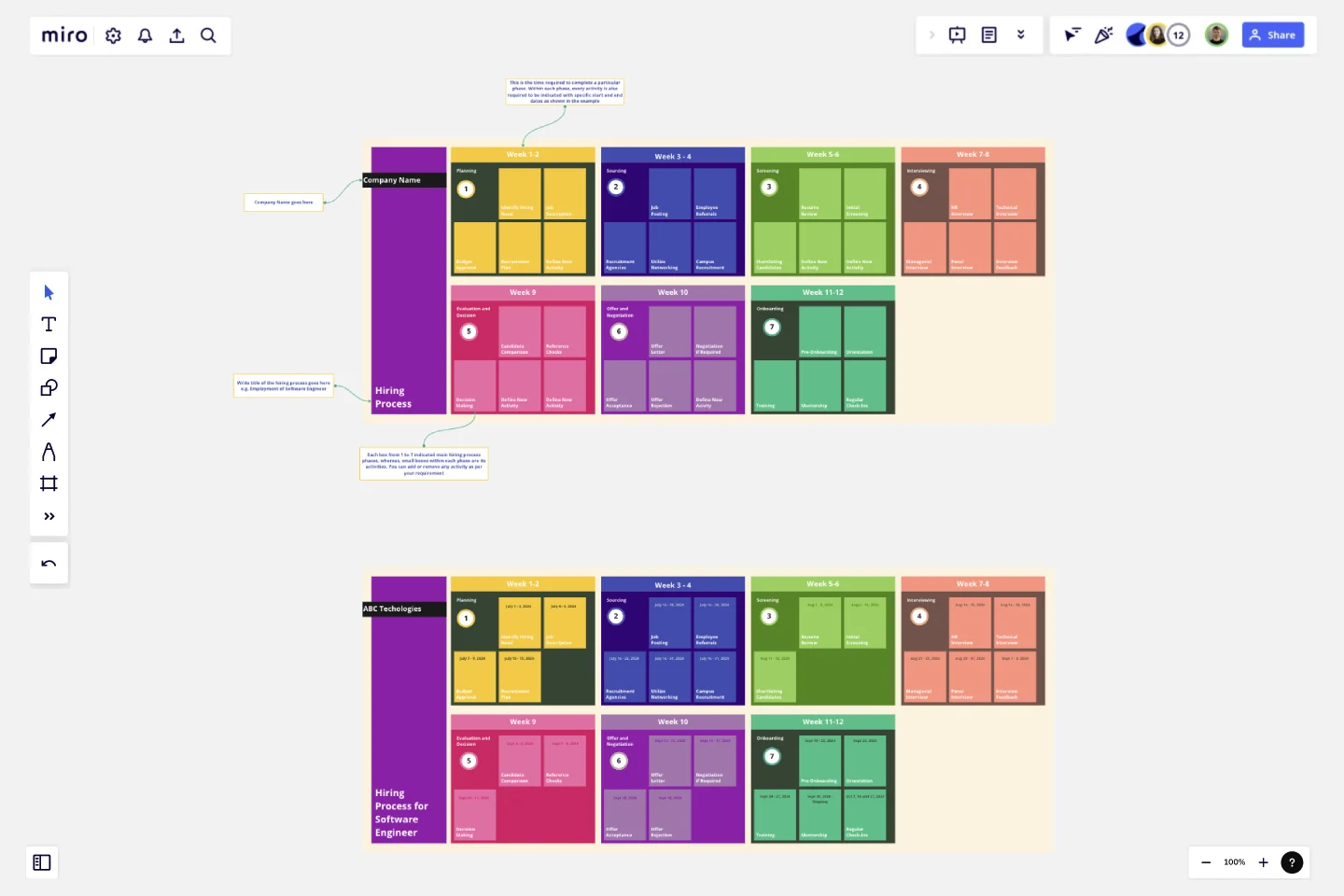Hiring Process Timeline
This Hiring Process Timeline template is designed to streamline and visualize the recruitment process for your organization.
The template is structured around seven key stages: Planning, Sourcing, Screening, Interviewing, Evaluation and Decision, Offer and Negotiation, and Onboarding. Each stage includes specific sub-tasks to ensure a comprehensive and efficient hiring process. An example for hiring a software engineer is provided to illustrate the use of the template.
How to Use the Template
Start with the Example: Review the provided example of the hiring process for a software engineer to understand how each stage and sub-task is mapped out.
Customize for Your Hiring Needs: Replace the example content with details specific to the position you are hiring for. Adjust the stages, sub-tasks, and timelines according to your recruitment process.
Update Regularly: Keep the timeline updated with the latest progress and changes. Use the template to track each stage of the hiring process and ensure no steps are missed.
Communicate with the Hiring Team: Use the template to provide regular updates to the hiring team, ensuring everyone is informed about the status of the recruitment process.
This template is a comprehensive tool designed to guide you through the entire hiring process, ensuring a systematic and effective approach to recruiting the best talent for your organization.
This template was created by Khawaja Rizwan.
Get started with this template right now.
The Product Storyboard
Works best for:
Product Management, Planning
The Product Storyboard template enables product managers to visualize product experiences and user journeys. By mapping out key touchpoints, interactions, and scenarios, this template helps teams understand user needs and pain points. With sections for defining user personas, storyboarding user flows, and capturing feedback, it supports iterative product design and validation. This template serves as a storytelling tool for communicating product visions and guiding product development efforts towards delivering exceptional user experiences.
Editorial Calendar Template
Works best for:
Marketing, Strategic Planning, Project Planning
If your company is like most, content is a big thing. You create more of it (and a lot faster) than you create almost anything else. It includes blogs, newsletters, social media posts, ads, and more—and it requires ideating, writing, editing, and publishing. That’s why every content team needs an editorial calendar. The template will let you easily create a calendar that empowers your team to plan strategically, keep things organized (by content type, writer, channel, and delivery date), and finalize/post all content on schedule.
RAID Log Template
Works best for:
Agile Methodology, Project Management, Agile Workflows
Use the RAID Log template to better understand potential risks, assumptions, issues, and dependencies relating to an upcoming project. With this information, you can make effective contingency plans and prepare your resources accordingly. You’ll know what could go wrong throughout the project and how to fix the problem.
Design Brief Template
Works best for:
Design, Marketing, UX Design
For a design to be successful, let alone to be great, design agencies and teams have to know the project’s goals, timelines, budget, and scope. In other words, design takes a strategic process—and that starts with a design brief. This helpful template will empower you to create a brief that builds alignment and clear communication between your business and your design agency. It’s the foundation of any creative project, and a single source of truth that teams can refer to all along the way.
Strategy Map Template
Works best for:
Leadership, Strategic Planning, Mapping
How do your individual or team goals relate to an organization’s overall strategy? A Strategy Map is a stylized picture of your organization’s strategy and objectives. It’s powerful because it provides a clear visual guide to how these various elements work together. Strategy Maps can help align various different team goals with the overall strategy and mission. With the Strategy Map in place, teams can create set actionable, relevant KPIs. Strategy mapping is often considered part of the balanced scorecard (BSC) methodology, which is a strategic planning tool for setting overall team goals.
AI Product Canvas
Works best for:
Product Management, Planning
The AI Product Canvas template facilitates the development of AI-powered products with a comprehensive framework. By defining AI capabilities, data requirements, and ethical considerations, this template guides teams through the AI product development process. With sections for identifying use cases, defining algorithms, and assessing model performance, it ensures that AI solutions meet user needs and ethical standards. This template serves as a strategic guide for developing innovative AI products that deliver value and drive business success.
